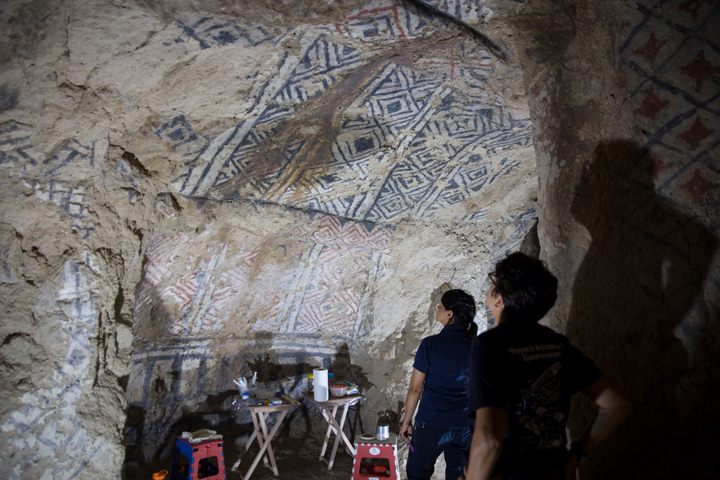
The Effort to Save Colombia’s Underground Mountaintop Tombs
Scientists and conservators are finally able to return to what was once an Andean war zone.
Deep in Colombia’s Cauca Department, once a war zone, Clemencia Vernaza is cloaked in darkness in an underground chamber. The art conservator is squinting through her glasses at some of the details etched and painted into the ancient volcanic rock in front of her. She pivots her flashlight up, like a child telling a scary story around a campfire, and the beam falls on a giant, monolithic face.
“Look at these black marks just around the eyes,” she murmurs, her fingers hovering over the deep black streaks painted along the brow of the sculpted face. They’re shrouded in darkness, but the walls all around her are painted with vivid red, black, gray, and white geometric patterns.
The chamber is a tomb, one of many that speckle the southwestern Colombian mountain ranges and make up the Parque Arqueológico Nacional de Tierradentro. Until very recently, the mountains and the intricate ruins they conceal were sealed from the world by the bloody war that raged around them.
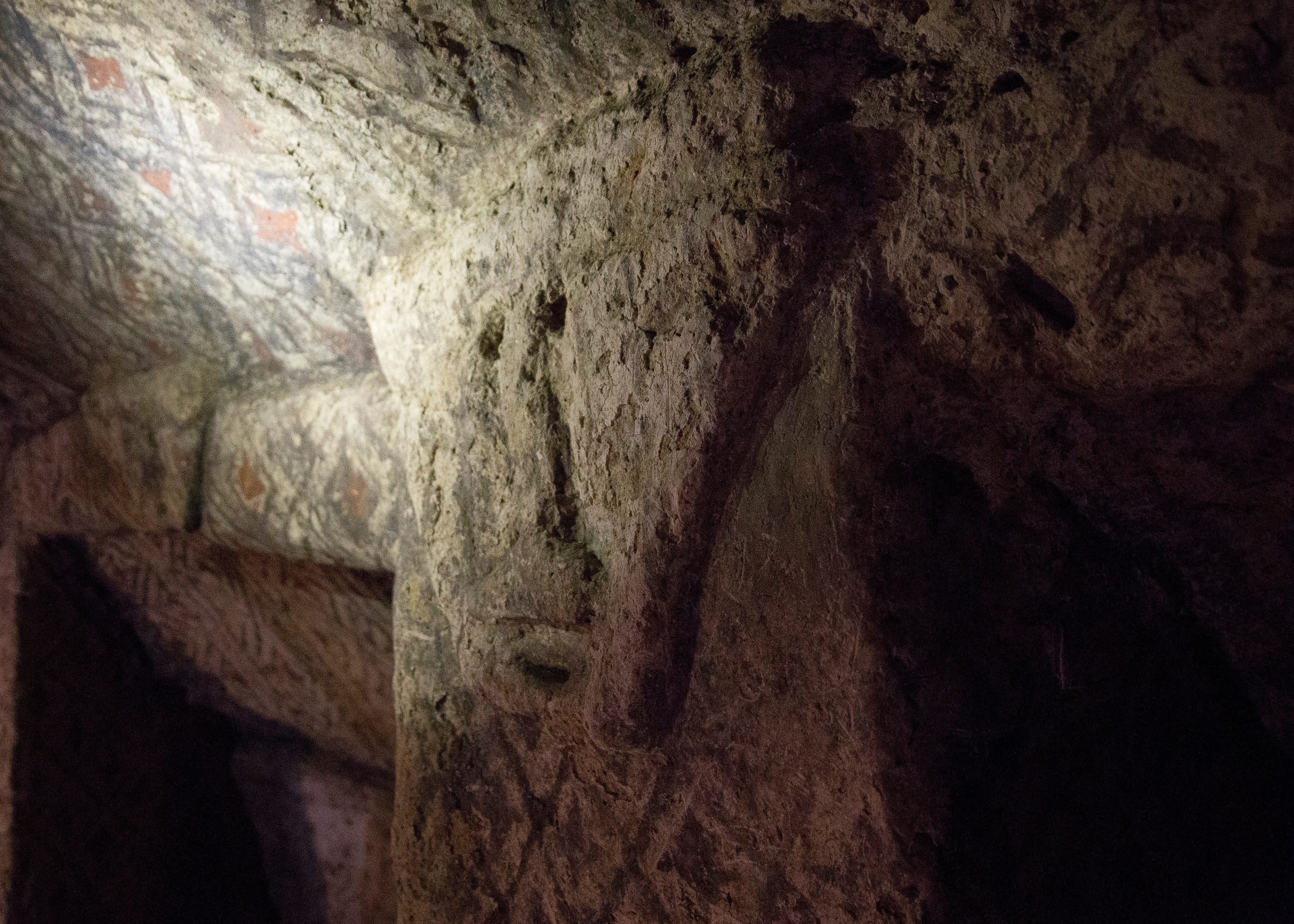
Tierradentro is a cluster of 162 burial chambers—called hypogea—hewn from the peaks of four cordilleras near the Andean town of Inza. They span a few miles of mountainous terrain, with the tomb entrances at the peaks. Small sets of stairs carved into volcanic stone descend into the tombs, some no larger than a closet and others with multiple rooms. They were created between 600 and 900, before Spanish colonization, as “homes for the dead” of the ancient society’s elite class, researchers say. Each site was adorned with vivid paintings, unique to the person buried there. Some bear monolithic carvings etched into floor-to-ceiling pillars, some are speckled with pieces of pottery. Small, rectangular holes had been carved into the volcanic stone as final resting places, though the remains appear to have been removed long ago. It’s almost as if the Valley of the Kings had been dropped into in among Andean peaks. There’s nothing like them in the Western Hemisphere.
The ruins that make up Tierradentro, meaning “inside earth,” are the largest and most elaborate concentration of pre-Columbian underground tombs in the Americas and were named a UNESCO World Heritage Site in 1995. Between Tierradentro and the more than 500 megalithic statues with human and animal features in neighboring San Agustín, the zone is the continent’s largest collection of prehistoric sculpture—and that includes Chile’s Easter Island. While a set of the ruins at Tierrodentro is open to visitors, many of the chambers are in dire condition.

The local Nasa indigenous people, also known as the Páez, have known of the tombs for ages, and the invading Spaniards also took note of them, but there was little study of them until in 1936, with a set of archaeological excursions that included Colombian archaeologist Gregorio Hernández de Alba. Over the decades some minimal research has been conducted, and in 1945, Colombia named Tierradentro a national archaeological park (and a national monument in 1993).
The ancient civilization is believed to be connected to the Nasa, but the mystery of the hypogeum and the society that made them continues to perplex researchers. “Tierradentro, it’s unique,” Vernaza says as she sits at the mouth of one tomb, looking out at the ranges in the distance, “But Tierradentro, we don’t know much about it. We have to do a lot of research and try to give it the attention it deserves because we don’t know exactly what there is, who created it, how they made it.”

Other historic UNESCO sites in Colombia, such as San Agustín or the Ciudad Perdida, or Lost City in the northern jungles, are well-known both within and outside of Colombia. Tierradentro, on the other hand, is more or less an unknown.
That’s because the tombs are in the heart of what was once Colombia’s red zone.
During the country’s more than half-century armed conflict, the region of Cauca was the site of a prolonged, bloody battle between fighters from the Revolutionary Armed Forces of Colombia, or FARC, and the Colombian military and right-wing paramilitary gangs. The windy, cliff-riddled road from the western city of Popayán to Tierradentro became famous for kidnappings and ambushes. The ruins themselves were practically off-limits to the outside world.

Oscar Parra grew up in the now-quaint riverside village of Inza, nestled among the cordilleras that hold the tombs, and has worked at the park for 40 years. As a child, he played near the hypogea, and after school helped a small cluster of scientists working in the park carry their materials down from the peaks for a few coins. But he describes his childhood as defined by a deep psychological terror, the stifling fear of becoming a target of either side of the conflict.
“If the guerrillas are here and you’re nearby, the army is going to attack you and think you’re a guerrilla,” Parra recalls, as he sits atop a peak where he once played, “so you wouldn’t know in what moment you could be killed.”
A 2016 pact between the government and FARC has created a tentative peace. Today there are only a few traces of the peril the area once represented—the total lack of development and a faded black “FARC” spray-painted on the back of a road sign.
This easing of tensions has opened the region to the world for the first time, allowing adventurous travelers to explore and researchers such as Vernaza and anthropologist Fernando Montejo to begin to unearth Tierradentro’s secrets—and work to save them.
It has long been believed that there are more undiscovered hypogea waiting to be found. The decorations and carvings in already-excavated sites indicate that the cultures that created Tierradentro and San Agustín were closely related. Research, Montejo says, could begin to put the ancient puzzle back together.
“It’s possible that there are more hypogea,” says Montejo, coordinator of the Anthropological Heritage Group of the Colombian Institute of Anthropology and History (ICANH). “But what’s certain is that there are archaeological sites in almost all of the regions. That’s why it’s important to research them: Because where there are hypogea, there are also important contexts to understanding the past of these populations.”
Montejo, Vernaza, and four other researchers, from institutions in Colombia, Mexico, and Switzerland trek into the mountains of Cauca, toward a set of ruins tucked in the far reaches of one of the peaks. The town below, nestled next to a winding river looks like a toy village from here. They swing open a door marking the entrance of one chamber, and climb down a large set of stone stairs into a network of dimly lit chambers, the largest of which is around 20 feet deep and 40 feet wide.

Vernaza and two others turn their flashlights to the walls of the tomb, setting the elaborate line paintings, carved surfaces, pillars and dusty pots on the ground aglow. Other researchers take pictures and carefully collect samples from the paintings and surrounding soil that might provide more information. The geometric zig-zags and thickly painted lines running the length of the chamber. Though abstract, the patterns are distinctive to each person in each tomb. The methods were revolutionary for that age, says researcher Manuel Espinosa, who examines the pigments, made with local clay and plant material, with a quarter-sized eyepiece. “Their knowledge was very deep and they were highly specialized,” he says. “This type of mural painting is not repeated in any other part of the world.”
In addition to study and documentation, the researchers have another concern: the ultimate fate of Tierradentro.
The ruins face rapid deterioration due to environmental factors such as erosion, the growth of vegetation, insects, and earthquakes. Human disturbances such as vandalism and the search for artifacts to loot have already irreparably damaged many of the sites. “They’ve been deteriorated,” Montejo says. “In some cases, they’ve been lost.” Chronic underfunding by the Colombian government, Montejo adds, makes matters worse.
A small handful of the hypogea closest to the village below are more or less intact, while other, ruins are in dire condition, with cracks winding across the walls like spider webs, chunks of carved rock in piles of rubble on the ground, and painted surfaces hanging precariously off the ceilings. Vernaza and others have focused on four of the tombs—within a 30-minute trek of the village—to save whatever they can.

Bottles, syringes, jars, and stools rest in an organized mess in a corner of the chamber. Using the soil around them, Vernaza has tried to develop a natural glue to reattach some of the more deteriorated parts of the painting. She leans in and injects this clay-glue with a measured hand, as she explains that she’s had to mix a variety of different solutions to get it just right.
“This here has fallen, there has fallen, here has fallen, too,” she says, gingerly touching the ravaged volcanic rock section she was working on.
The highest of Tierradentro’s four peaks, El Alto de Aguacate, lies in Nasa indigenous land and is home to 62 of the tombs. There, much farther from Inza, land conflicts between the government and the Nasa have left many of the hypogea “practically abandoned,” says Elias Sevilla, an anthropologist at Universidad del Valle in Cali.

Ten years ago, Sevilla scaled that mountain, up a steep incline through banana and lemon trees for more than an hour. The scenery was breathtaking, he says, but the state of decay of the tombs was horrifying: ravaged by the elements, moss growth, and graffiti. Only faint traces of the once vibrant paintings remain there, Sevilla says. “These tombs that are open are endangered,” he says. “And if you don’t protect them, they’re going to deteriorate.” And with them, the chance to learn more about Colombia’s origins.
Archaeologists and conservators believe the newfound peace—and a small but growing number of visitors—will be key to studying and saving the park. But for now triage is the best they can do.
Vernaza peers up at her work. The cracks she’s filled with clay-glue criss-cross with the black and red strokes of the original artists.
“It’s marvelous,” she says, “But it honestly needs urgent attention.”



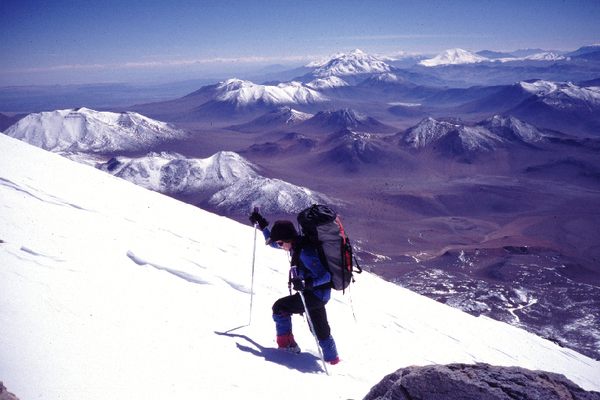
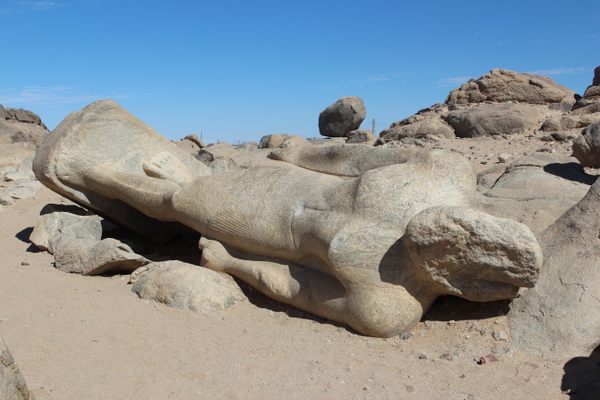

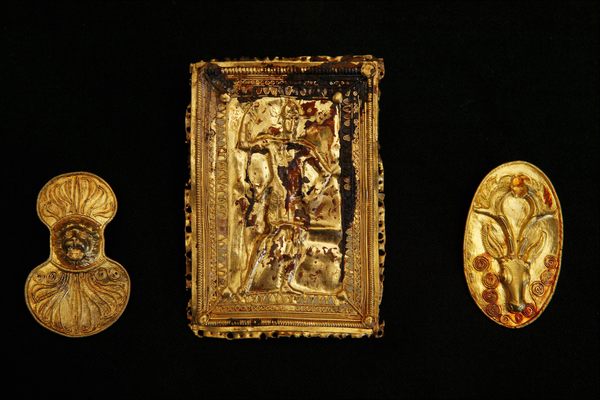








Follow us on Twitter to get the latest on the world's hidden wonders.
Like us on Facebook to get the latest on the world's hidden wonders.
Follow us on Twitter Like us on Facebook